Abstract
The paper presents long-term changes in water temperature in two rivers, Oder and Neman, with catchments showing different climatic conditions (with dominance of marine climate in the case of the Oder and continental climate in the case of the Neman River). A statistically significant increase in mean annual water temperature was recorded for four observation stations, ranging from 0.17 to 0.39 °C dec−1. At the seasonal scale, for the winter half-year, water temperature increase varied from 0.17 to 0.26 °C dec−1, and for the summer half-year from 0.17 to 0.50 °C dec−1. In three cases (Odra-Brzeg, Odra-Słubice, Niemen-Grodno), the recorded changes referred to the scale of changes in air temperature. For the fourth station on Neman (Smalininkai), an increase in water temperature in the river was considerably slower than air temperature increase. It should be associated with the substantial role of local conditions (non-climatic) affecting the thermal regime in that profile. Short-term forecast of changes in water temperature showed its further successive increase, a situation unfavorable for the functioning of these ecosystems.
1. Introduction
Water temperature in rivers is one of the basic properties determining a number of processes occurring in these ecosystems, consequently shaping their environmental and economic potential. This statement refers to water quality, biodiversity, etc. One of the basic indicators of water quality is the content of dissolved oxygen, dependent on water temperature. According to Morrill et al. [1], in places with currently low dissolved oxygen content, an increase in water temperature in summer may cause its decrease to a critically low level, endangering many water species. Water temperature affects spawning periods and indicators of growth and mortality of organisms inhabiting rivers for which life processes occur in a particular thermal range [2]. Research concerning the occurrence of cyanobacteria in four main rivers of South Korea shows that water temperature is an important predictor of their abundance [3]. Research on thermal conditions in rivers is conducted in many dimensions [4,5,6]. One of the directions leading in recent years is the issue concerning the effect of climate warming on the thermal regime of flowing waters. An increase in water temperature is confirmed in the majority of analyzed cases [7,8,9,10,11], and its rate depends on the effect of other environmental factors. Next to climatic conditions, the thermal regime of a river can be determined by among others water discharge in the river, power plants, dams, etc. [12,13,14].
Changes in current conditions of the functioning of rivers caused by an increase in water temperature are currently evident. An increase in water temperature in Alpine rivers in the case of the population of brown trout caused a shift of the thermal habitat up the river [15]. In the case of Danube, Abonyi et al. [16] determined that one of the components of long-term change in the functional phytoplankton system was temperature increase. In the case of Prosna, a river in central Poland, the recorded increase in water temperature contributed to a reduction of the ice season, leading to further ecological consequences [17]. A successive increase in warming will cause further transformation of the thermal regime of rivers in the future [18,19], with all the broadly defined consequences of the process. Despite rich knowledge in the scope of the relations between the atmosphere and hydrosphere, many large rivers important for particular countries or regions still require a detailed investigation concerning changes in elementary characteristics, including water temperature. This is exemplified by the Oder and Neman Rivers flowing into the Baltic Sea, analyzed further in the paper.
2. Experiments
2.1. Study Area
The primary objective of the study was the determination of long-term changes in water temperature in the Oder and Neman Rivers (Figure 1) in the context of changes in air temperature in the years 1965–2014. The secondary objectives were the determination of differences between the rivers which despite their location only several hundred kilometers from each other are under the influence of different air masses, with the dominance of marine climate in the case of Oder, and continental in the case of the Neman River.
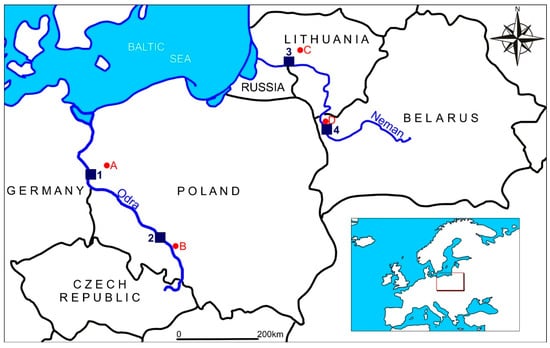
Figure 1.
Location of the study objects: hydrological stations (1: Oder–Słubice, 2: Oder–Brzeg, 3: Nema–Smalininkai, 4: Neman–Grodno), meteorological stations (A: Gorzow Wlkp, B: Opole, C: Raseiniai, D: Grodno).
The Oder River catchment is located at a latitude of 49°24’–53°59’ and longitude of 13°26’–19°43’, in the territory of the Czech Republic, Germany, and Poland. The total length of the river is 854 km, and its catchment has an area of 118,610 km2. The largest tributaries of the Oder River in terms of length and catchment area are Warta, Bóbr, and Barycz. Mean annual discharge at the mouth of the Oder River is approximately 570 m3/s. The catchment of the Neman River is located at a latitude of 56°15′–52°45′ and longitude of 22°40′–28°10′, in the territory of Belarus, Lithuania, Russian Federation, Poland, and Latvia. The total length of the river is 914 km, and its catchment has an area of 98,200 km2. Both rivers are similar in terms of length, volume of discharge, as well as catchment size. The estuaries of Oder and Neman are located at a distance of only approximately 500 km. Nonetheless, the vicinity of Oder to the ocean through the North Sea, and Neman to extensive land masses to the east, determine their considerable influence on the rivers. This is evidenced by the indices of thermal continentalism, expressed as the degree of effect of land masses on the climate of a given area. The degree increases into the land, and decreases toward the surface of oceanic waters. Therefore, high values of mean annual temperature amplitude are recorded deep into the continent, and lower values are typical of coastal areas of Europe. The Oder catchment shows precipitation-nival regime, and the Neman catchment nival-precipitation regime [20]. Figure 2 presents the Oder and Neman Rivers on the background of the distribution of the thermal continentalism index according to Conrad. In the case of the Oder River and its catchment, the effect of oceanic climate is evident—the index is 20–26%. Neman and its catchment are in the zone of index 24–30%, i.e., the effect of continental climate is evident.
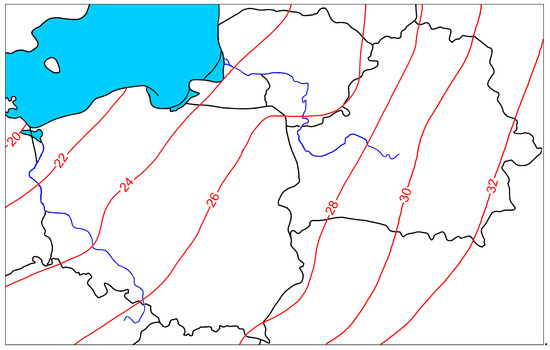
Figure 2.
The spatial distribution of the thermal continentalism index according to Conrad (%), (after [21], changed).
2.2. Materials and Methods
The paper employed data of the Institute of Meteorology and Water Management—National Research Institute (IMGW-PIB) obtained for the Oder River: stations Brzeg and Słubice. The collected information included mean values of water temperature measurements. Water temperature measurements were performed on a point basis at water gauges, at a depth of 0.4 m under the water surface. Based on observations conducted by IMGW-PIB, mean monthly air temperatures were collected from stations Opole and Gorzów Wlkp. for the multi-annual period corresponding with the conducted hydrological measurements. In the case of water temperature in the Neman River, the research employed data for two measurement stations Smalininkai and Grodno. Air temperature from two stations was provided, namely Raseiniai and Grodno, respectively. In the case of stations Smalininkai and Raseiniai, the data were collected based on observations of the Lithuanian Hydrometeorological Service, and the two remaining ones based on monitoring conducted by Belhydromet.
The statistical analysis of long-term water and air temperature fluctuations in the Oder and Neman Rivers was conducted in estimates of quasiperiodicity, autocorrelation, trend, and uniformity of statistical series. Parametric and non-parametric criteria were applied, such as the autocorrelation coefficient, Spearman rank correlation coefficient, t-Student test, and F Fisher test [22]. The methodology of temperature analysis for the purposes of forecasting was based on the analysis of similarity of spectral images of water and air temperature [23]. The spectral density of the studied rivers was analyzed in time periods according to the following formula [24]:
where: —radian frequency; —period; m—maximum change of the ordinate of the autocorrelation function; —smoothing function; —autocorrelation function.
For the smoothing function, the Nuttall window was adopted [25]:
where: —weighting coefficients (; ; ; ).
The level of significance of the spectrum starts from the zero hypothesis H0: water levels are represented as “white noise.” The confidence interval for the empirical values of spectrum S* is expressed with the following formula [26]:
where: and —values of the right-side quantiles of Pearson distribution ; —number of degrees of freedom; α—significance level (α was adopted as 0.05).
The number of degrees of freedom for the Nuttall window for the period n and maximum change m is calculated by the following formula:
Autoregressive integrated moving average (ARIMA) proposed by Box and Jenkins [27] was applied for forecasting temperature series with an evident trend. The ARIMA model includes three parameters: p—autoregressive parameter, d—order of difference operations, and q—moving average parameter [27,28,29]. The ARIMA model is an addition to autoregressive moving average models (ARMA(p,q)), and is used for the description of stationary time series. The process of construction of the ARIMA(p,d,q) model involves three stages [30]:
- (a)
- Identification of the model;
- (b)
- Assessment and verification of the adequacy of the model;
- (c)
- Application of the model in forecasting.
Identification of the model means the determination of parameters p, d, and q. The first stage is implemented through defining and analysis of the autocorrelation function (ACF) and partial autocorrelation function (PACF) of the time series. The analysis is possible only for stationary time series. Therefore, the original time series must be reduced to stationary in one of the following ways:
- -
- Finding direct and (or) seasonal differences (i.e., determination of the value of parameter d);
- -
- Selection of a trend and (or) filtering seasonal (periodical) fluctuations.
The evidence of transformed stationary series is a decrease in ACF and PACF values with an increase in lag. This stage permits developing a basic set including one, two, or even more models, i.e., a model portfolio. In the practice of research on hydrometeorological series, the majority of them can be approximated with a satisfactory degree of accuracy by means of one of five models presented in Table 1.

Table 1.
Determination of model parameters via autocorrelation function (ACF) and partial autocorrelation function (PACF) figures.
The second stage of development of the model involves assessment of parameters of ARIMA models by means of the method of maximum similarity, and verification of the adequacy of the obtained ARIMA models. Their comparison employed several criteria: estimates of coefficients of the model must be statistically significant, and the residues of the model must show the properties of white noise. If several ARIMA models are appropriate, it is necessary to select a model with the lowest number of parameters, and best statistical properties of quality of fit of the model for which the Akaike information criterion (AIC) and Bayesian Information Criterion (BIC) were applied [31,32].
The Box–Jenkins method can also be applied in modelling the behavior of time series with an evident periodical seasonal component. The seasonal periodical model is determined by ARIMA (p,d,q)(Ps,Ds,Qs). Like parameters of a simple ARIMA model, the parameters are called: seasonal autoregression (Ps), seasonal difference (Ds), and seasonal moving average (Qs). The parameters are calculated for series obtained after adopting one difference with a lag of 1, and then seasonal difference. Seasonal lag applied for seasonal parameters is determined at the stage of identification of the model order by means of periodograms and spectrograms.
3. Results
Table 2 presents information concerning water temperature in the analyzed rivers and meteorological stations.

Table 2.
Mean monthly and annual water and air temperature.
According to the above, mean annual water temperature in both rivers and the corresponding meteorological stations are mutually variable. The differences are particularly evident in the winter–spring period. Water temperatures in the Oder River are higher than those in the Neman River in autumn, winter, and early spring, whereas in March the differences exceed as much as 3 °C. In late spring and summer, water temperatures of both rivers are similar, and mean water temperature in Neman (Grodno) is the highest, reaching 20.8 °C. Such a situation should be associated with the location of the analyzed rivers, and greater effect of marine climate in the case of Oder, and continental in the case of the Neman River. All the analyzed pairs of stations show statistically significant correlations between the series of water and air temperature—from 0.74 for the pair Brzeg-Opole to 0.88 of the pair Słubice-Gorzów Wlkp.
Long-term changes in water temperature in all four analyzed stations were subject to considerable transformation, particularly related to air temperature (Figure 3).
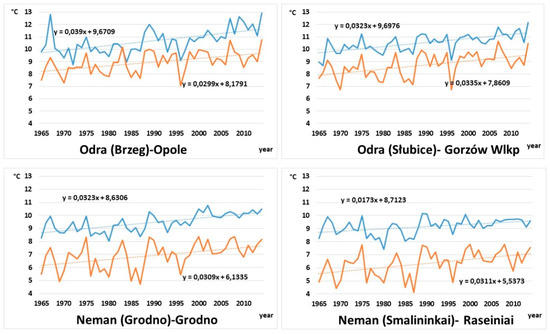
Figure 3.
Changes in mean annual water (blue) and air (orange) temperature in the years 1965–2014; statistically significant linear trends at the level 0.05 and their equations (straight dotted lines).
A statistically significant increase in mean annual water temperature was recorded for all cases, varying from 0.17 to 0.39 °C dec−1. At the seasonal scale, for the winter half-year, an increase in water temperature was in a range from 0.17 to 0.26 °C dec−1, and for the summer half-year from 0.17 to 0.50 °C dec−1. In the case of mean annual air temperature, its increase varied from 0.29 to 0.32 °C dec−1, and in the analogical seasons it was in a range from 0.27 to 0.40 °C dec−1, and from 0.20 to 0.31 °C dec−1. In the case of three out of four analyzed hydrological stations, the recorded changes generally corresponded to the scale of changes in air temperatures. Station Smalininkai (Neman), and the corresponding meteorological station Raseiniai, are different in all the above time periods. In that case, an increase in water temperature in the river was considerably slower than an increase in the air temperature, which should be associated with the significant role of local factors (non-climatic) affecting the thermal regime in that profile which will be specified later.
The spectral analysis of water and air temperature performed in the paper for the Oder and Neman Rivers based on annual and monthly temperature values showed that their annual spectra have smooth curves with no considerable peaks (Figure 4). Monthly spectra of air and water temperature present curves with peak values of 3, 4, 5, and 7 years of fluctuations, as well as curves with no considerable peaks (Figure 5). Spectra of water temperature for the Oder River usually show 4-, 5-, and 7-year fluctuations. Simultaneously, 3-, 4-, and 7-year fluctuations were recorded for water temperature in the Neman River, particularly in the winter season (from November to April). Spectra of air temperatures in the Oder River catchment are presented in 3- and 4-year fluctuations, and in summer months (from May to October), 4-year fluctuations usually occur. Air temperature in station Niemen Grodno are characterized by curves with 4 and 7-year fluctuations. Air temperature in station Raseiniai is characterized by curves with 4-, 5-, and 7-year fluctuations. 4-year variability is characteristic of the majority of spectra of air and water temperatures, as shown in Figure 4 (example spectra of May months). This result is in accordance with earlier research on the issue, where Boryczka and Stopa-Boryczka [33] determined that time series of air temperature in Europe show approximately 4-year periodicity.
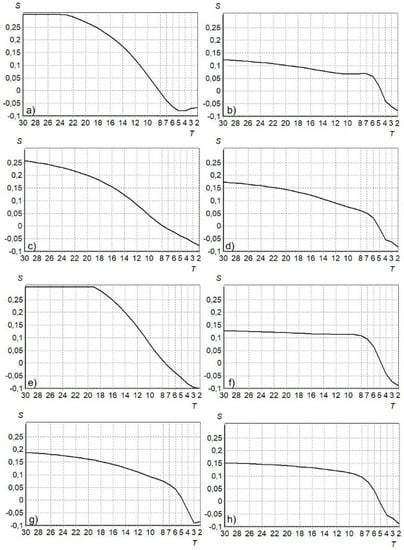
Figure 4.
Mean annual spectra of water and air temperature for the Oder and Neman Rivers: (a,b) Odra (Brzeg)-Opole, (c,d) Odra (Słubice)- Gorzów Wlkp, (e,f) Niemen (Grodno)-Grodno, (g,h) Niemen (Smalininkai)-Raseiniai.
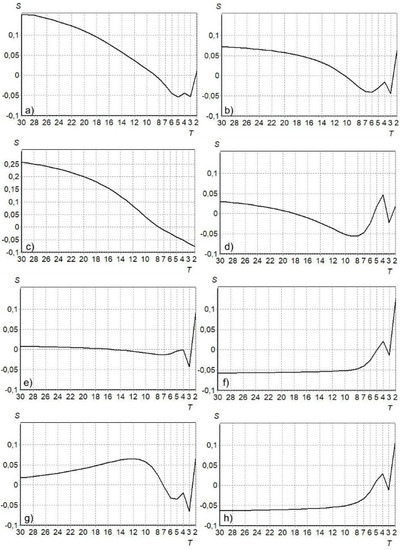
Figure 5.
Monthly spectra of water and air temperature for the Oder and Neman Rivers—example for May: (a,b) Odra (Brzeg)-Opole, (c,d) Odra (Słubice)-Gorzów Wlkp, (e,f) Niemen (Grodno)-Grodno, (g,h) Niemen (Smalininkai)-Raseiniai.
Similar spectrum images of water and air temperatures were used as basic data for forecasting future temperature with the application of the determined considerable peaks and local and regional conditions. All the considered temperature series were forecasted in prolongation to the existing data by 20 years by constructing ARIMA models. Temperature forecast was exemplified by a number of mean annual water temperatures for station Oder-Brzeg. The visual analysis of the diagram of mean annual water temperature (Figure 3, Oder-Brzeg) shows that the series has considerable fluctuations and a linear trend, i.e., it is probably non-stationary. ACF and PACF of the series were developed for a more rational conclusion regarding non-stationary character (Figure 6).
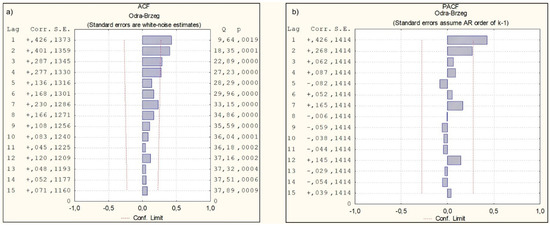
Figure 6.
ACF (a) and PACF (b) of the average annual water temperature for station Oder-Brzeg (Cols: Lag, Correlation, Standard Error, Q and P— parameters).
In reference to ACF, coefficients of autocorrelation of lags 1–4 differed from zero, pointing to the presence of a trend and non-stationary character of the initial series of temperatures. Due to this, the trend was excluded from the original series in order to transform it into the stationary form (Figure 7).
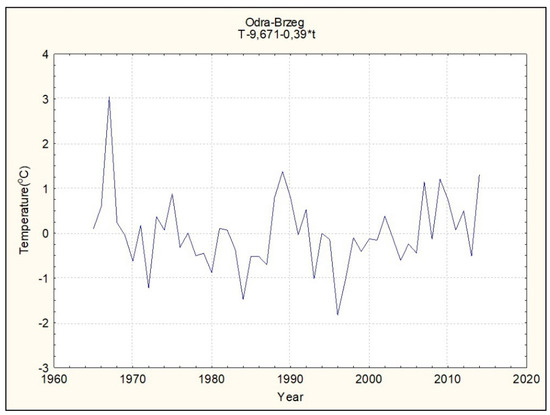
Figure 7.
Average annual water temperature with the excluded trend (for Oder-Brzeg trend is T = 0.39 × t + 9.671).
For series with the excluded trend, there are no significantly non-zero coefficients ACF and PACF, which points to the stationary character of the transformed series (Figure 8).
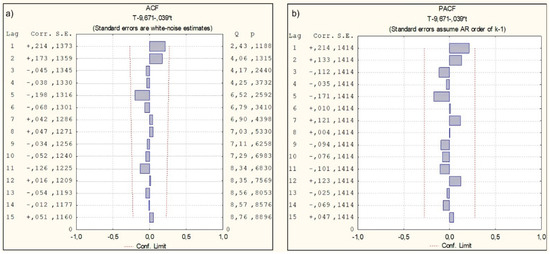
Figure 8.
ACF (a) and PACF (b) for mean annual water temperature for station Oder-Brzeg with the excluded trend (Cols: Lag, Correlation, Standard Error, Q and P—parameters).
The order of autoregressive and moving averages was determined in accordance with guidelines included in Table 1. Parameters Ds and Qs were calculated for series obtained after adopting one difference with lag 1, and then seasonal difference with lag 1–4 (obtained from the analysis of the diagram of spectrum density). As a result, the following values of parameters were obtained: d = 1, p = 1, q = 2, Ds = 1, Qs = 0, Ps = 2. The model was therefore represented as ARIMA (1,1,2) (2,1,0). The result of the forecast of the transformed series for the selected model is presented in Figure 9.
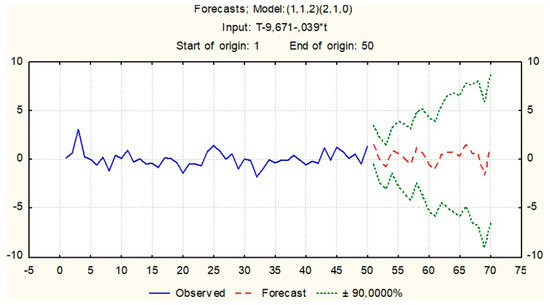
Figure 9.
Forecast of mean annual water temperature for station Oder-Brzeg for the selected ARIMA model (blue—observed values; red—forecasted values; green—±90% confidence interval).
Figure 9 shows observed and forecasted mean annual water temperature, as well as upper and lower bounds of the 90% confidence interval. Using confidence intervals permits evaluation of the reliability of the forecast. The confidence interval indicates a 90% probability that the predicted values are within the specified interval.
The final forecast of the original series was performed through adding a trend and modelled values of the transformed series with the excluded trend. ARIMA models for other temperature series were constructed analogically. Results of the forecasted values by 2034 are presented in Figure 10.
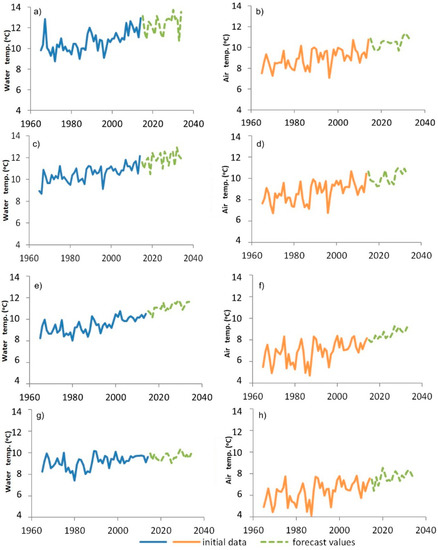
Figure 10.
Predicted temperatures of water and air temperature for the Oder and Neman Rivers: (a) Odra (Brzeg), (b) Opole, (c) Odra (Słubice), (d) Gorzów Wlkp, (e) Niemen (Grodno), (f) Grodno, (g) Niemen (Smalininkai), (h) Raseiniai (±90% confidence interval).
According to the above forecast, an increase in air, and consequently water temperature will continue to progress. According to the results obtained based on the modelling, mean water temperature can be higher by a value from 0.5 °C (station Niemen-Smalininkai) to 1.7 °C (stations Oder-Brzeg and Neman-Grodno). Mean air temperature can increase by a value from 1.4 °C (stations Gorzów Wlkp and Raseiniai) to 1.6 °C (station Grodno).
4. Discussion
As shown above, the differences in the course of water temperature in both rivers resulting from their location in regions with different climatic conditions were most evident in mean monthly and mean annual values, and less in the rate of water temperature increase. In the case of mean monthly water temperatures, the greatest differences between the rivers were recorded in March (more than 3.5 °C), when spring conditions occurred in the Oder River catchment, and in the case of Neman, air temperatures oscillated around 0 °C. The results obtained in the study point to an evident transformation of the thermal regime of both rivers, where an increase in water temperature has been recorded in all the analyzed stations over the last half a century. The result corresponds with the global research trend, pointing to successive warming of water in flowing water ecosystems. For example, in the case of five rivers on the southern coast of the Baltic Sea, an average recorded increase in water temperature was 0.28 °C dec−1 [34]. It was primarily caused by the simultaneously recorded increase in air temperature. Žganec [35], analyzing long-term changes in water temperatures in rivers in central Croatia, determined their increase varying from 0.17 to 0.48 °C dec−1. Observations conducted in the territory of the Czech Republic over a period of 28 years showed that the effect of climate changes was manifested in an increase in water temperature in rivers by 1.15 °C [36]. Research on British rivers in the period 1982–2011 shows that they were subject to warming, on average at a level of 0.22 °C dec−1, and the highest increase was recorded for April: 0.63 °C dec−1 [37]. In the case of five semi-natural mountain rivers in the Carpathians, significant increasing trends of annual water temperature were observed, with a variable rate (0.33–0.92 °C dec−1). Increasing trends of water temperature were the strongest in summer and autumn, and weakest in winter [38]. Results similar to those from earlier studies were obtained in the case of forecasting further changes in water temperature in both rivers analyzed in this paper. The projection of mean temperature in the summer period for the Frase River (Canada) showed that in the years 2070–2099 the temperature would be higher by 1.9 °C [39]. For the Saint John River, Dugdale et al. [40] determined that mean water temperature would increase by approximately ~1 °C in the period 2070–2074, and by further ~1°C in the years 2095–2099. Research conducted for the Rhein shows that water temperature in the period 2071–2100 will be higher in a range from +1.9 to +2.2°C [41]. According to numerous studies, the further course of water temperature in rivers is closely related to climate changes, and the obtained temperature increases depending on the local properties of particular rivers, and the adopted model assumptions.
It should be emphasized that river water temperature is correlated with air temperature [42,43]. The statement was confirmed in three out of four cases analyzed in the paper, where the rate of increase in water temperature and the corresponding air temperatures in the nearest meteorological stations were similar. In this context, profile Smalininkai on Neman is a separate case, where the course of water temperature is significantly determined by the local conditions. Jurgelėnaitė et al. [44], analyzing the spatial distribution of water temperature in rivers in Lithuania, evidenced that their thermal regime is significantly determined by several factors (among others the type of alimentation of the river, occurrence of sandy soils, etc.). Moreover, it should be emphasized that in front of station Smalininkai, Neman is supplied with high amounts of water from its largest tributary, namely the Neris River (Wilia). The Neris River catchment is located in the northern part of the Neman catchment, it is considerably more forested, and receives considerably more groundwater.
The share of groundwaters was emphasized by Latkovska, Apsite [45], analyzing changes in water temperature in rivers in Latvia, where lower water temperatures were determined to occur in rivers with a high rate of groundwater supply.
The recorded changes are, and in the future will be of considerable importance for the functioning of the analyzed rivers. The correlation of dissolved oxygen (DO) in water and water temperature is unquestionable [17,46]. Dissolved oxygen is one of the most important indicators of biological health of rivers [47]. Therefore, based on the reverse dependency of water temperature and dissolved oxygen, the observed increase of the former will contribute to the worsening of water quality. Such a situation will contribute to obstacles for the policy in the scope of management of water resources, and activities aimed at the improvement of their state. Another important issue is the effect of water temperature on the hydrobiological conditions occurring in the river. Changes in the thermal regime observed in the case of the Rhein limit complete renewal of the native fish fauna, and facilitate the functioning of exotic species, increasing competition between native and exotic species [48]. According to long-term scenarios of climate change, Kriaučiūnienė et al. [49], analyzing the issues of ichthyofauna of Lithuanian rivers, predicted the relative abundance of stenothermal fish to decrease from 24 to 51% by the end of this century, and that of eurythermal fish to probably increase from 16 to 38%. In the context of the above studies and results obtained in this paper, the species composition of fish will probably also be subject to transformations in the analyzed rivers.
5. Conclusions
Results presented in the paper, referring to the properties of the thermal regime of the Oder and Neman Rivers, based on the analysis of mean annual and monthly water temperatures pointed to the variability between them. Such a situation should be associated with their location in zones of dominating influence of two types of climate: marine in the case of the Oder River, and continental in the case of the Neman River. In terms of the rate and scale of changes in water temperature, they were at a similar level, whereas it should be emphasized that in one of the cases a considerably lower rate of temperature increase was observed. Such a situation is determined by local conditions, and not climatic conditions at the regional scale. The short-term simulation of future changes in water temperature showed its further increase, with an unfavorable effect on the functioning of these ecosystems. The confirmation of the broader research trend concerning the effect of climate changes on water temperature appears evident, although it was evidenced that local properties of rivers and their catchments can considerably slow down the effects of global warming. This finding is important for institutions managing water resources, facing decisions aimed at undertaking activities mitigating changes in the thermal regime of rivers.
Author Contributions
Conceptualization, A.C.; methodology, S.P.; software, S.P.; investigation, A.C., I.K., S.P.; data curation, I.K., G.V., M.P.; writing—original draft preparation, A.C., S.P., M.P.; writing—review and editing P.K., S.S.; supervision, A.V.; project administration, M.P.; All authors have read and agreed to the published version of the manuscript.
Funding
This research received no external funding.
Institutional Review Board Statement
Not applicable.
Informed Consent Statement
Not applicable.
Data Availability Statement
The datasets used in this study are available in: Institute of Meteorology and Water Management—National Research Institute, Lithuanian Hydrometeorological Service and Belhydromet.
Acknowledgments
The authors thank anonymous reviewers, whose comments help to improve the quality of the manuscript.
Conflicts of Interest
The authors declare no conflict of interest.
References
- Morrill, J.C.; Bales, R.C.; Conklin, M.H. Estimating stream temperature from air temperature: Implications for future water quality. J. Environ. Eng. 2005, 131, 139–146. [Google Scholar] [CrossRef]
- Harvey, R.; Lye, L.; Khan, A.; Paterson, R. The influence of air temperature on water temperaturę and the concentration of dissolved oxygen in Newfoundland Rivers. Can. Water Resour. J. 2011, 362, 171–192. [Google Scholar] [CrossRef]
- Cha, Y.; Cho, K.H.; Lee, H.; Kang, T.; Kim, J.H. The relative importance of water temperature and residence time in predicting cyanobacteria abundance in regulated rivers. Water Res. 2017, 124, 11–19. [Google Scholar] [CrossRef]
- Morales-Marín, L.A.; Sanyal, P.R.; Kadowaki, H.; Li, Z.; Rokaya, P.; Lindenschmidt, K.E. A hydrological and water temperature modelling framework to simulate the timing of river freeze-up and ice-cover breakup in large-scale catchments. Environ. Model. Softw. 2019, 114, 49–63. [Google Scholar] [CrossRef]
- Briciu, A.-E.; Mihaila, D.; Graur, A.; Oprea, D.I.; Prisacariu, A.; Bistricean, P.I. Changes in the water temperature of rivers impacted by the urban heat island: Case study of Suceava city. Water 2020, 12, 1343. [Google Scholar] [CrossRef]
- Wang, Y.; Zhang, N.; Wang, D.; Wu, J. Impacts of cascade reservoirs on Yangtze River water temperature: Assessment and ecological implications. J. Hydrol. 2020, 590, 125240. [Google Scholar] [CrossRef]
- Marszelewski, W.; Pius, B. Long-term changes in temperature of river waters in the transitional zone of the temperate climate: A case study of Polish rivers. Hydrol. Sci. J. 2016, 61, 1430–1442. [Google Scholar] [CrossRef]
- Bui, M.T.; Kuzovlev, V.V.; Zhenikov, Y.N.; Füreder, L.; Seidel, J.; Schletterer, M. Water temperatures in the headwaters of the Volga River: Trend analyses, possible future changes, and implications for a pan-European perspective. River Res. Appl. 2018, 34, 495–505. [Google Scholar] [CrossRef]
- Kaushal, S.S.; Likens, G.E.; Jaworski, N.A.; Pace, M.L.; Sides, A.M.; Seekell, D.; Belt, K.T.; Secor, D.H.; Wingate, R.L. Rising stream and river temperatures in the United States. Front. Ecol. Environ. 2010, 8, 461–466. [Google Scholar] [CrossRef]
- Basarin, B.; Lukić, T.; Pavić, D.; Wilby, R.L. Trends and multi-annual variability of water temperatures in the river Danube, Serbia. Hydrol. Process. 2016, 30, 3315–3329. [Google Scholar] [CrossRef]
- Chen, D.; Hu, M.; Guo, Y.; Dahlgren, R.A. Changes in river water temperature between 1980 and 2012 in Yongan watershed, eastern China: Magnitude, drivers and models. J. Hydrol. 2016, 533, 191–199. [Google Scholar] [CrossRef]
- Casado, A.; Hannah, D.M.; Peiry, J.-L.; Campo, A.M. Influence of dam-induced hydrological regulation on summer water temperature: Sauce Grande river, Argentina. Ecohydrology 2013, 6, 523–535. [Google Scholar] [CrossRef]
- Gallice, A.; Bavay, M.; Brauchli, T.; Comola, F.; Lehning, M.; Huwald, H. StreamFlow 1.0: An extension to the spatially distributed snow model Alpine3D for hydrological modelling and deterministic stream temperature prediction. Geosci. Model Dev. 2016, 9, 4491–4519. [Google Scholar] [CrossRef]
- Liu, H.; Sun, S.; Zheng, T.; Li, G. Prediction of water temperature regulation for spawning sites at downstream of hydropower station by artificial neural network method. Trans. Chin. Soc. Agric. Eng. 2018, 34, 185–191. [Google Scholar]
- Hari, R.E.; Livingstone, D.M.; Siber, R.; Burkhardt-Holm, P.; Güttinger, H. Consequences of climatic change for water temperature and brown trout populations in Alpine rivers and streams. Glob. Chang. Biol. 2006, 12, 10–26. [Google Scholar] [CrossRef]
- Abonyi, A.; Ács, É.; Hidas, A.; Grigorszky, I.; Várbíró, G.; Borics, G.; Kiss, K.T. Functional diversity of phytoplankton highlights long-term gradual regime shift in the middle section of the Danube River due to global warming, human impacts and oligotrophication. Freshw. Biol. 2018, 63, 456–472. [Google Scholar] [CrossRef]
- Ptak, M.; Nowak, B. Zmiany temperatury wody w Prośnie w latach 1965-2014. Woda-Środowisko-Obszary Wiejskie 2017, 17, 101–112. [Google Scholar]
- Liu, D.; Xu, Y.; Guo, S.; Xiong, L.; Liu, P.; Zhao, Q. Stream temperature response to climate change and water diversion activities. Stoch. Environ. Res. Risk Assess. 2018, 32, 1397–1413. [Google Scholar] [CrossRef]
- Soto, B. Climate-induced changes in river water temperature in North Iberian Peninsula. Theor. Appl. Climatol. 2018, 133, 101–112. [Google Scholar] [CrossRef]
- Fiziko-Gieograficzeskij Atłas Mira; Akademija Nauk SSSR i Gławnoje Uprawlenije Gieodezji i Kartografji GGK SSSR: Moskwa, Russia, 1964.
- Witek, M.; Bednorz, E.; Forycka-Łaawniczak, H. Kontynentaizm termiczny w Europie. Bad. Fizjogr. 2015, 66, 171–182. [Google Scholar]
- Anderson, T. The Statistical Analysis of Time Series; John Wiley & Sons: Hoboken, NY, USA, 2011; 704p. [Google Scholar]
- Volchak, A.; Choiński, A.; Kirviel, I.; Parfomuk, S. Spectral analysis of water level fluctuations in Belarusian and Polish lakes. Bull. Geogr. Phys. Geogr. Ser. 2017, 12, 51–58. [Google Scholar] [CrossRef]
- Družinin, V.; Sikan, A. Pajonirovanie territorii Severo-Zapada RF po uslovijam formirovanija godovogo stoka. In Vodnye Resursy Severo-Zapadnogo Regiona Rossii; Gidrometeorologicheskii Universitet: Saint Petersburg, Russia, 1999; pp. 24–29. [Google Scholar]
- Marple, S. Cifrovoj Spektral’nyj Analiz i Ego Priloženija; Mir: Moscow, Russia, 1972. [Google Scholar]
- Kajsl, Č. Analiz Vremennych Rjador Gidrologičeskich Dannych; Gidrometeoizdat: Leningrad, Russia, 1972. [Google Scholar]
- Box, G.; Jenkins, G. Time Series Analysis: Forecasting and Control; Holden-Day: San Francisco, CA, USA, 1970. [Google Scholar]
- Balyani, Y.; Niya, G.F.; Bayaat, A. A study and prediction of annual temperature in Shiraz using ARIMA model. J. Geogr. Space 2014, 12, 127–144. [Google Scholar]
- El-Mallah, E.S.; Elsharkawy, S.G. Time-series modeling and short term prediction of annual temperature trend on Coast Libya using the box-Jenkins ARIMA Model. Adv. Res. 2016, 6, 1–11. [Google Scholar] [CrossRef]
- Etuk, H.E.; Moffat, U.I.; Chims, E.B. Modelling monthly rainfall data of portharcourt, Nigeria by seasonal box-Jenkins method. Int. J. Sci. 2013, 2, 60–67. [Google Scholar]
- Akaike, H. A new look at the statistical model identificatio. IEEE Trans. Autom. Control 1974, 19, 716–723. [Google Scholar] [CrossRef]
- Schwarz, G. Estimating the dimension of a mode. Ann. Stat. 1978, 6, 461–464. [Google Scholar] [CrossRef]
- Boryczka, J.; Stopa-Boryczka, M. Cykliczne wahania temperatury i opadów w Polsce w XIX-XXI wieku. Acta Agrophys. 2004, 3, 21–33. [Google Scholar]
- Ptak, M.; Choiński, A.; Kirviel, J. Long-term water temperature fluctuations in coastal rivers (Southern Baltic) in Poland. Bull. Geogr. Phys. Geogr. Ser. 2016, 11, 35–42. [Google Scholar] [CrossRef]
- Žganec, K. The effects of water diversion and climate change on hydrological alteration and temperature regime of karst rivers in central Croatia. Environ. Monit. Assess. 2012, 184, 5705–5723. [Google Scholar] [CrossRef]
- Hrdinka, T.; Vlasák, P.; HaveL, L.; Mlejnská, E. Possible impacts of climate change on water quality in streams of the Czech Republic. Hydrol. Sci. J. 2015, 60, 192–201. [Google Scholar] [CrossRef]
- Jonkers, A.R.T.; Sharkey, K.J. The differential warming response of Britain’s rivers (1982–2011). PLoS ONE 2016, 11, 0166247. [Google Scholar] [CrossRef]
- Kędra, M. Regional response to global warming: Water temperature trends in semi-natural mountain river systems. Water 2020, 12, 283. [Google Scholar] [CrossRef]
- Morrison, J.; Quick, M.C.; Foreman, M.G.G. Climate change in the Fraser River watershed: Flow and temperature projections. J. Hydrol. 2002, 263, 230–244. [Google Scholar] [CrossRef]
- Dugdale, S.J.; Allen Curry, R.; St-Hilaire, A.; Andrews, S.N. Impact of Future Climate Change on Water Temperature and Thermal Habitat for Keystone Fishes in the Lower Saint John River. Can. Water Resour. Manag. 2018, 32, 4853–4878. [Google Scholar] [CrossRef]
- Hardenbicker, P.; Viergutz, C.; Becker, A.; Kirchesch, V.; Nilson, E.; Fischer, H. Water temperature increases in the river Rhine in response to climate change. Reg. Environ. Chang. 2017, 17, 299–308. [Google Scholar] [CrossRef]
- Arora, R.; Tockner, K.; Venohr, M. Changing river temperatures in northern Germany: Trends and drivers of change. Hydrol. Process. 2016, 30, 3084–3096. [Google Scholar] [CrossRef]
- Ptak, M. Long-term temperature fluctuations in rivers of the Fore-Sudetic region in Poland. Geografie 2018, 123, 279–294. [Google Scholar] [CrossRef]
- Jurgelenaite, A.; Kriaučiuniene, J.; Šarauskiene, D. Spatial and temporal variation in the water temperature of Lithuanian rivers. Baltica 2012, 25, 65–76. [Google Scholar] [CrossRef]
- Latkovska, I.; Apsite, E. Long-term changes in the water temperature of rivers in Latvia. Proc. Latv. Acad. Sci. Sect. B Nat. Exactand Appl. Sci. 2016, 70, 78–87. [Google Scholar] [CrossRef]
- Riđanović, L.; Riđanović, S.; Jurica, D.; Spasojević, P.; Bijedić, D. Evaluation of Water Temperature and Dissolved Oxygen Regimes in River Neretva. BALWOIS 2 Ohrid 2010, 25, 29. [Google Scholar]
- Rajwa-Kuligiewicz, A.; Bialik, R.J.; Rowiński, P.M. Dissolved oxygen and water temperature dynamics in lowland rivers over various timescales. J. Hydrol. Hydromech. 2015, 63, 353–363. [Google Scholar] [CrossRef]
- Leuven, R.S.E.W.; Hendriks, A.J.; Huijbregts, M.A.J.; Lenders, H.J.R.; Matthews, J.; van der Velde, G. Differences in sensitivity of native and exotic fish species to changes in river temperature. Curr. Zool. 2011, 57, 852–862. [Google Scholar] [CrossRef]
- Kriaučiūnienė, J.; Virbickas, T.; Šarauskienė, D.; Jakimavičius, D.; Kažys, J.; Bukantis, A.; Kesminas, V.; Povilaitis, A.; Dainys, J.; Akstinas, V.; et al. Fish assemblages under climate change in Lithuanian rivers. Sci. Total Environ. 2019, 661, 563–574. [Google Scholar] [CrossRef]
Publisher’s Note: MDPI stays neutral with regard to jurisdictional claims in published maps and institutional affiliations. |
© 2021 by the authors. Licensee MDPI, Basel, Switzerland. This article is an open access article distributed under the terms and conditions of the Creative Commons Attribution (CC BY) license (https://creativecommons.org/licenses/by/4.0/).